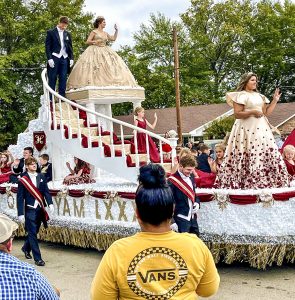Hanging Out At The Yamboree Parade
It was beginning to look as if we would not be able to escape from the Gilmer square last Saturday morning.
My Beautiful Mystery Companion and I had driven up to watch the East Texas Yamboree Queen’s parade because our nephew, Connor, was marching with the Harmony High School Band. He plays trombone and is also a talented pianist. However, it’s not practical to march while playing a piano.
The Yamboree began in 1935. Like most everything else, last year’s was canceled, and there was a three-year hiatus during World War II. Other than those years, the Yamboree has been a Northeast Texas staple. The festival was organized to celebrate the sweet potato harvest, after an infestation of weevils forced farmers to stop growing the crop for several years in the 1920s.
Yams and sweet potatoes are basically the same thing in these parts – an orange-fleshed root crop that is quite nutritious. Its origin is Africa. When the weevil quarantine in the mid-1930s ended, the East Texas Yamboree was organized at the behest of state officials. They encouraged counties to come up with festivals in advance of the state’s centennial in 1936. Now the four-day Yamboree features two parades, on Friday and Saturday; the queen’s coronation; a livestock and ag mechanic s show; concert and barn dance; carnival rides and all manner of festival food –including, of course, sweet potato pie. The square is blocked off for four days, and thousands of folks line the streets for the two parades.
s show; concert and barn dance; carnival rides and all manner of festival food –including, of course, sweet potato pie. The square is blocked off for four days, and thousands of folks line the streets for the two parades.
The parade began with a color guard from the Gilmer High ROTC, followed by a number of marching bands. The floats were elaborate, especially the one holding the queen and her court, all dressed in elaborate long gowns. They stood ramrod straight as the floats inched along. A number of antique vehicles were interspersed between the floats, including some fine old tractors – including a Poppin’ Johnny John Deere, so called because of its distinctive exhaust sound. This one was likely a restored 1930s vintage.
Connor’s dad, Jim, had figured out the best vantage point where we could spot Connor as the Harmony band came past, then walk two blocks and catch him again at the tail end of the parade. Connor grinned as he saw us while marching past. The Harmony band is small but spirited with a dedicated band director, who walked along in a shirt, necktie and straw hat.
Once we saw Connor a second time, we parted ways with Jim and visited with a young man who has opened a woodworking shop on the square. Hank Jenkins, 19, is the son of Jim’s next-door neighbor. He dived into woodworking during the pandemic, and has become quite an artist, creating cutting boards and other items from a variety of woods. It is heartening to see his initiative. His shop is well worth a visit.
We decided to buy a corn dog and then leave. That turned out to be more of a challenge than we anticipated. The parade was still circling the square, blockades were up at every corner, and police officers stood at the intersections to discourage jaywalkers like us. We walked around the square several times, looking for an escape route. It was like “Hotel California:”
You can check-out any time you like,
But you can never leave!
Finally, a gap appeared between the parade entries, as a band marked time to provide more space before they started marching. We dashed across the red-brick streets and through a gap in the line. Crossing U.S. Hwy. 271, the main thoroughfare through Gilmer, was an adventure, but we achieved it without mishap. Soon we were on our way home. There’s a backroads route from our home (which has a Gilmer mailing address though it’s in Gregg County, a few miles north of Longview) to Gilmer that makes for a lovely drive down country roads with rolling pastures filled with cows, horses and donkeys, picturesque barns and stately trees. We rolled down the windows and enjoyed the breeze.
Soon we were home, and I pulled on my boots, put on mosquito repellent and headed to the tractor to see how much more I could get cleared out back. I have learned you can mow down head-high weeds and even small saplings with a bushhog, but it’s dirty, sweaty work.
That corndog was rumbling in my stomach as I mowed. That carnie corndog might have been a tactical error, but it seemed like a good idea at the time.
Leave a reply
Fields marked with * are required











